Introduction & Highlights
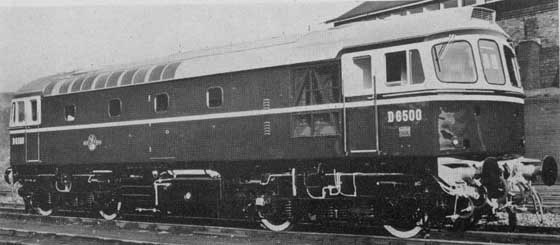
The BRCW/Sulzer/CP Type 3s (later Class 33) were not part of the 1956 Modernisation Plan's initial order for 171 (later 174) locomotives. There was a large gap between the Mixed Traffic Type B orders (maximum of 1,250bhp) and the Heavy Duty Type C orders (minimum 2,000bhp). Thus in August 1957 the locomotive range was expanded and redesignated with the 1,500bhp - 1,750bhp range now designated Class (Type) 3. In placing the specifications for the Type 3, the Southern Region had a very clear idea of what was required, including some features which were outside of the BTC's specifications. These requirements included:
Haulage of 700 ton freight trains on ruling gradients of 1 in 70
Haulage of 375 ton passenger & van trains over electrified and non-electrified routes
Fitting of equipment to provide electric train heating
Ability to haul electric multiple unit stock at normal speeds over all routes in times of emergency
Maximum service speed of 85mph
Ability to work vacuum & air-braked rolling stock
A wide route availability
Four months later an order was placed with BRCW for 45 Class 3 Bo-Bo locomotives, to be numbered D6500 - D6544. Although outside of the original Modernisation Plan locomotives, they were an obvious development of the Class 2 type 1,160bhp locomotives D5300 - D5319. The writer does not have information on tenders for this first order, but tender information is shown below for the second order.
Details of the proposals for the 2nd order of the BRCW Type 3s (20 locomotives) reveal that four tenders were received, these were probably very similar to the tenders for the first 45 BRCW Type 3s. These proposals replicate those accepted in October 1955 for the Pilot Scheme D5300, D5500 and D5700 series, albeit with larger engines.
1/ The tender from English Electric kept everything in-house, powered by an 18cyl 1,700hp Deltic engine, the mechanical portion based on the Bo-Bo Baby Deltic with a larger engine. £88,299
2/ The tender from Brush saw the mechanical & electrical kept in-house with power equipment offered from Mirless, Sulzer & Maybach, with A1A or Bo-Bo wheel arrangements. £87,650, £94,850, £81,550,
3/ The tender from BRCW saw BRCW handle the mechanical build, with a Sulzer engine and Crompton Parkinson electrical equipment with a Bo-Bo wheel arrangement. £78,940
4/ The tender from Metropolitan Vickers saw Metropolitan Cammell handle the mechanical portion, MV the electrical equipment, with power units from Sulzer, Mirlees & Paxman, wheel arrangements were A-1-A or Co-Co. £99,368, £104,172, £92,291, £96,978, £87,213, £103,588.
The BTC Works & Equipment Committee met on November 12th 1958 to decide on the above tenders and recommended an order to BRCW on the basis of price.
The Southern Region had no requirement for access between locomotives whilst in service so the cab front gangway doors as found in the Class 26s were eliminated and the use of the Southern Region two character roller blind route indicators avoided the clutter of the train identification discs also found on the Class 26s.
Four orders were placed for a total of 98 locomotives:
45 locomotives in December 1957
20 locomotives in October 1958
12 locomotives in July 1959 (narrow bodied variant, body profile of 8'8" instead of standard 9'3".)
21 locomotives in May 1960
Deliveries were:
38 taken into stock in 1960 (D6500 - D6537)
41 taken into stock in 1961 (D6538 - D6578)
19 taken into stock in 1962 (D6579 - D6597)
The BRCW build numbers were from No.92 (of 1959) to No.189 (of 1961). Build No.157 to No.168 were allocated to the narrow bodied variant (D6586 - D6597), which although ordered in July 1959 were delivered after the final order placed in May 1960 (D6564 - D6585). The delivery of the Class 33s by BRCW was preceded by the Class 26s, there was about a month's gap between the last Class 26 delivery and the first Class 33. Between June 1961 & May 1962 BRCW was delivering both Class 27s & Class 33s. (The final Class 27 was delivered in September 1962). The Class 33 was in many ways similar to the Class 26, but from an electrical viewpoint there were some interesting differences. The requirement for electric train heating saw an additional generator being fitted. A rating of 250kW was needed to handle the load of ten coaches, with the ability to pre-heat more from time to time. The train heating generator would only produce a constant output with the engine running at 550rpm to 750rpm. This required the engine to idle at a minimum of 550rpm when the heating switch was on but the Master controller handle was in the Off position. Once the Master controller moved to the On position the train heating supply would momentarily be switched off until the controller reached a predetermined position. This would assure smooth starts.
Additionally the use of the Class 33s on the Night Ferry service required them to be able to handle the different heating system used by the Continental sleeping cars. The BR system used a two pole system with a protective interlock, the Continental system used a single pole, requiring locomotives working these services to be equipped with two different connections between the locomotive and rolling stock. SR locomotives carried three buttons on the heating control panel instead of the more normal two.
Another difference affected the radiator cooling fan. The Class 26 used an electric motor to power the fan. For the Class 33 with its increased power equipment a hydrostatic system was selected utilising an engine driven pump and a hydrostatic pump motor. The transmission oil lines reached pressures of 1,500lb/sq in, invariably with such high pressures leaks occurred, particularly at the joints. Over time lessons were learned in their repair which greatly improved the reliability of the hydrostatic cooling system.
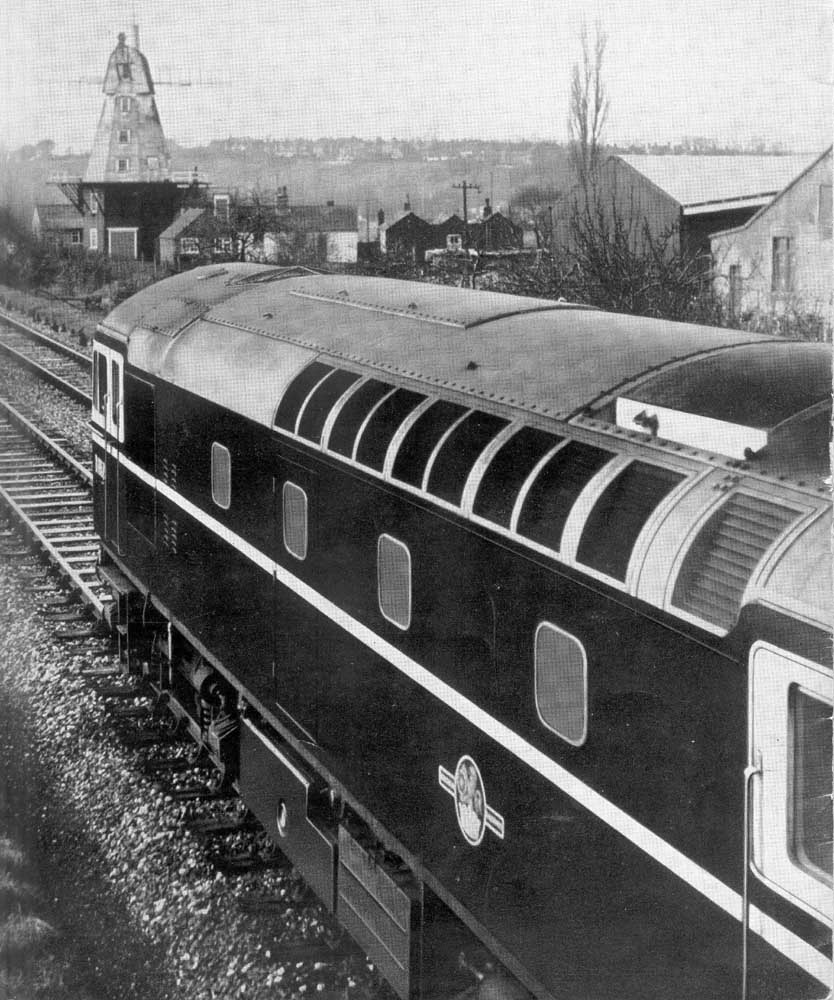
The photograph is taken at Rye with the Type 3 heading towards Hastings and is about to cross the River Tillingham. The town of Rye is behind the photographer. The windmill has since become a bed & breakfast.![]()
The Power Unit
The 8LDA28 power unit selected for the Type 3 was available from the Sulzer catalogue, with the eight cylinder also being offered in the smaller 8LD22 & 8LD25 range. Generally this model did not produce many orders, in the United Kingdom it would be the only eight cylinder inline power unit fitted to a British Railways Modernisation Plan locomotive or one of its derivatives. Whilst generally the Type 3 was an evolution from the BRCW Type 2, the eight cylinder engine did require some changes because of its larger output. With such an engine either the fitting of two turbochargers or the use of one turbocharger equipped with four entries for exhaust gas were the preferred choices. For the Type 3 a single twin entry turbocharger was selected which would produce satisfactory results but with certain consequences. There would be reduced valve overlaps in order to prevent exhaust/inlet pulse interferences, higher exhaust temperatures would result due to reduced scavenging time and optimum combustion would not be as easily achieveable over the whole load/speed range. These characteristics would cause the engines to generally run hotter than their six cylinder counterparts.
As with all the 6LDA28 engines, so the 8LDA28 suffered from 'teething troubles'. The early discovery of cracked pistons was resolved by modifications introduced from June 1959. (Were the Type 3s delivered from new with the modified pistons?) They also suffered from cylinder head failures, which occurred earlier and more frequently than with the 6LDA28 range. Replacement with a modified, strengthened cylinder head resolved the problem.
Although the Sulzer catalogue included a B & C variant for the 8LDA28 none were ordered by British Railways. A Vickers built 8LDA28 had been sent to Winterthur for testing, allowing the C rating to be provided, being rated 1,800bhp at 800rpm.
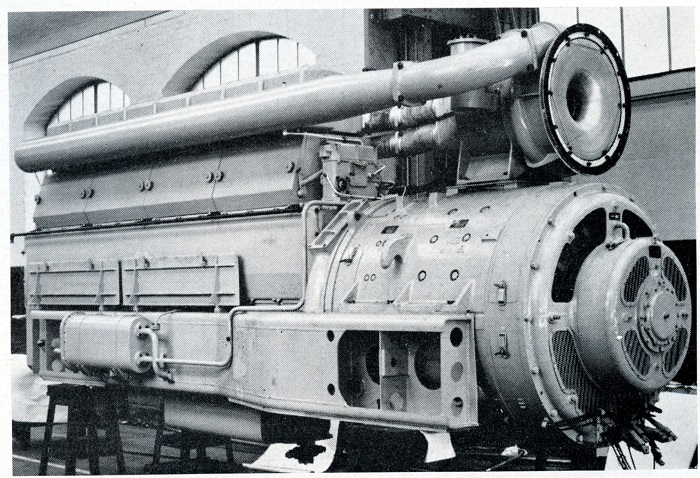
![]()
1959
BRCW also tendered for the first Type 3 Class 37s. At a meeting on January 11th 1959 the committee handling new locomotive orders accepted the bid from English Electric, although BRCW offered the lowest price. The committee was concerned whether BRCW could fulfil the order, in view of the commitment for 33 additional ĎD6500sí for the Southern Region.
December: D6500 delivered on schedule, though not officially accepted into traffic until the following month. It was noted at Hither Green shed on December 17th for crew training.
![]()
1960
Early in March D6500 & D6501 were noted together being tested with ten coach sets through Tonbridge. Towards the end of the month D6502 was being tested as far as Dover via Shepherdswell.
The summer timetable found the Charing Cross/Cannon Street main line services to Dover/Ramsgate in the hands of diesels, including the D65xx series. They were also occasionally to be found working the Dover Boats trains and the relief Night Ferry. For steam heated stock during the winter months a Derby Type 2 was required to provide heating, though frequently this instruction was not always followed.
On June 3rd brand new D6510 & D6511 were noted en-route from Smethwick to the Southern Region.
July 1960: Following clearance tests the Class were given almost universal acceptance over Southern metals, they were banned from seven minor branches and the Hastings - Tonbridge route with the exception of the yet to be built narrow bodied examples.
July 17th: D6506, E5004 & 20001 were noted at Balcombe Tunnel Junction track testing station. Several runs at varying speeds were made between Three Bridges and Balcombe or Haywards Heath. Four days later D6506 was noted working passenger and goods trains on the Allhallows-on-Sea branch.
During October D6500 & D6515 were noted at Eastleigh Works.
![]()
1961
February: The electrification of the West Coast main line would see many Mk 1 passenger coaches converted to electric heating, prior to the full scale conversion of this stock a test train was run between Ferme Park and Craigentinny, Edinburgh using electrically heated coaches powered by D6504. On February 10th D6504 and eight coaches ran from Derby to Peterborough and Kings Cross. The train then ran each night for four nights to a fast schedule, departing Kings Cross for Craigentinny on 14th & 16th, then returning south on 15th & 17th. Kings Cross crews worked the train throughout, with a pilotman north of York. During this testing D6504 was shown as on loan effective February 12th to the LMR (Derby) for allocation purposes.
March: Night visits were made by a D65xx locomotive to the Lewes - Barcombe Mills line for the purpose of testing bridges in conjunction with West Country Pacific No. 34008 Padstow.
May: Between May 11th & 14th an exhibition of locomotives and rolling stock was staged at Marylebone parcels depot by the BTC to celebrate the Golden Jubilee of the Institution of Locomotive Engineers. Locomotives exhibited included brand new BRCW Type 3 No. D6553 (33035). Others present were steam locomotives: MR Compound 1000, LNER A4 60022 'Mallard', BR 8P 71000 'Duke of Gloucester', BR 9F 92220 'Evening Star', Gas Turbine 4-6-0 GT3, diesel locomotives: North British Type 1 No.8400, Brush Type 2 No 5699 (31269), Beyer Peacock Hymek Type 3 No.7000, BR Swindon Warship Type 4 No.867, BR Derby Peak Type 4 No.28 (45124), English Electric Deltic Type 5 No.9003 (55003) and electric locomotives E5014 & E3059 (85004).
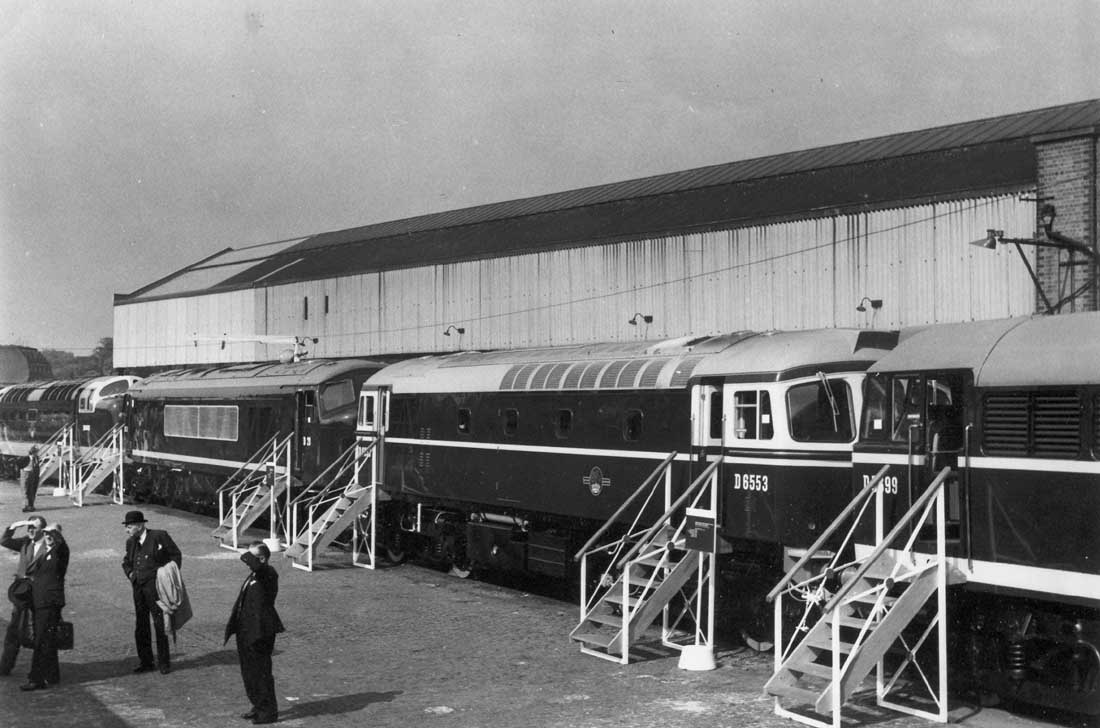
On May 29th D6537 worked a Gillingham - Ely excursion throughout.
June: Full electric passenger workings commenced between London and the Kent Coast ports. A handful of services remained diesel hauled. However in general most of the diesels would be released to replace steam on the area freight workings.
November 25th: two eleven coach football specials were run from Dartford to Bristol, Ashton Gate using the combinations of D5013 & D6573 and D5009 & D6523, the Derby Type 2s being used to heat the trains. The first mentioned ran to Kensington where modified Hall No. 6960 Raveningham Hall took over for a run down the Western Region main line to Bristol. The second special had a bit more of an adventure, retaining its original motive power and running via Clapham Junction, Salisbury, Westbury and Bath to Bristol. Did this working provide Bristol with its first sight of a Derby Type 2 & a BRCW Type 3?
The shipment of cement from APCM's plant in Kent to distribution depots in Scotland had previously taken place by coastal shipping. With the recent introduction of PCV Cemflo wagons the movement of the cement by rail became a competitive reality. The new fleet of Cemflo wagons (285 wagons) were of a light alloy construction rather than being all-steel allowing for a payload of 26.8 tons instead of 23.5 tons. This increased payload and the running of trains with up to thirty wagons provided the economic incentive to switch to rail. The new wagons would service a new loading facility at Cliffe and a new distribution depot at Uddingston (Glasgow).
Because the train required a reversal on route brake vans were added at either end, these being roller bearing fitted and vacuum piped. The trainswere routed Cliffe - Hoo Junction - Crayford - Kensington Olympia - Dalston (reversal to Finsbury Park) - ECML to Edinburgh Suburban Line - Shotts - Uddingston.
Initially pairs of Class 33s worked the trains to Ferme Park where steam locomotives would take the train forward. From December 4th the 2.30am Holborough (Cliffe) - Uddingston and 2.45am return working were dieselised between Holborough and York using pairs of Type 3s. The standard load was 28 tanks. The loaded northbound working was due at York at 10.40am, the southbound empties at 11.40am, the smart turn round made possible by the greater flexibility of the new diesels. Beyond York Class 40s would take over. Diesel failures often saw steam/diesel combinations occurring. On occasions when there were no return empties the diesels ran light back to the Southern Region. In order to accommodate the training of Eastern Region crews through to York several Type 3s were loaned to Finsbury Park including D6504 (2/61) & D6559 (11/61) and New England: D6556 (11/61), D6517 (12/61), D6559 (12/61), D6541 (10/62) & D6553 (7/63).
During 1962 the pairs of Class 33s were reduced to one locomotive between Ferme Park and York.
December: The Type 3s were also frequent visitors on cross-London freights from the Southern Region to Temple Mills Yard.
![]()
1962
A couple of the Uddingston bound cement trains required assistance from steam locomotives, on January 18th 9F No.92044 assisted D6513, whilst on February 10th A3 No.60106 assisted D6517.
With the delivery commencing of the narrow bodied D6596 - D6597 for use on the Tonbridge - Hastings line, the few remaining steam locomotives operating over this route were either withdrawn or transferred away.
April 7th: Brighton was the destination for narrow bodied D6586, having run light from Tonbridge, two days were spent at Brighton before returning to Tonbridge.
April: D6503 visited Eastleigh for driver training on the oil trains out of Fawley. It was initially tested between Fawley and Eastleigh on a variety of tank train workings. However in the last week of April it was tested on the 1.00pm Fawley - Spondon tanks as far as Didcot, returning with the 8.20pm Didcot - Eastleigh freight. These trains were routed over the Didcot, Newbury & Southampton line, possibly a first for the Type 3's. D6503 returned to Hither Green on April 26th, D6505 & D6526 were then loaned to Eastleigh. On June 5th the 6.55pm Eastleigh - Fawley freight was double headed by D6505 & 3MT 82014.
May: The last Type 3, No.D6597 was delivered to Hither Green, for a short while the whole class would be allocated here. With the entire fleet in traffic and the delivery of the first Electro Diesels taking place, the fifteen loaned Derby Type 2s started to return to the LMR. From May 21st the Holborough - Uddingston cement train saw its load increased to thirty three wagons, a gross load of just under 1,100 tons. By the summer this working would be handled south of York by a single BRCW Type 3, resulting in some mixed results with regard to reliability.
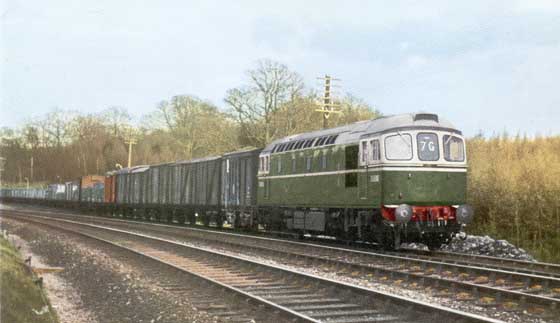
June 25th: the imminent departure of the Queen Elizabeth from Southampton saw the running of at least three boat trains, D6526, D6535 & D6583 provided haulage.
July: Eastleigh received its first allocation of Type 3s with twelve transferred from Hither Green for use on the oil trains from the nearby Fawley ESSO Petroleum refinery and its increasing volume of rail bourne oil traffic. One of the more well known workings was to Bromford Bridge, others went to Denham, Tiverton Junction & Tavistock Junction. The new diagrams introduced on July 2nd to eliminate double heading on the Fawley line met with some disagreement, so the recently transferred diesels migrated to passenger workings between Bournemouth West, Southampton, Eastleigh and Waterloo.
August: The sphere of activity for the Type 3s continued to expand in the Central Division, included were the Sutton & Mitcham area freight workings, some empty coach stock workings between New Cross Gate and London Bridge, assorted engineering workings and an early morning diagram between London Bridge & Brighton. They were also visitors to Brighton & Eastbourne on summer passenger workings from the Hastings area.
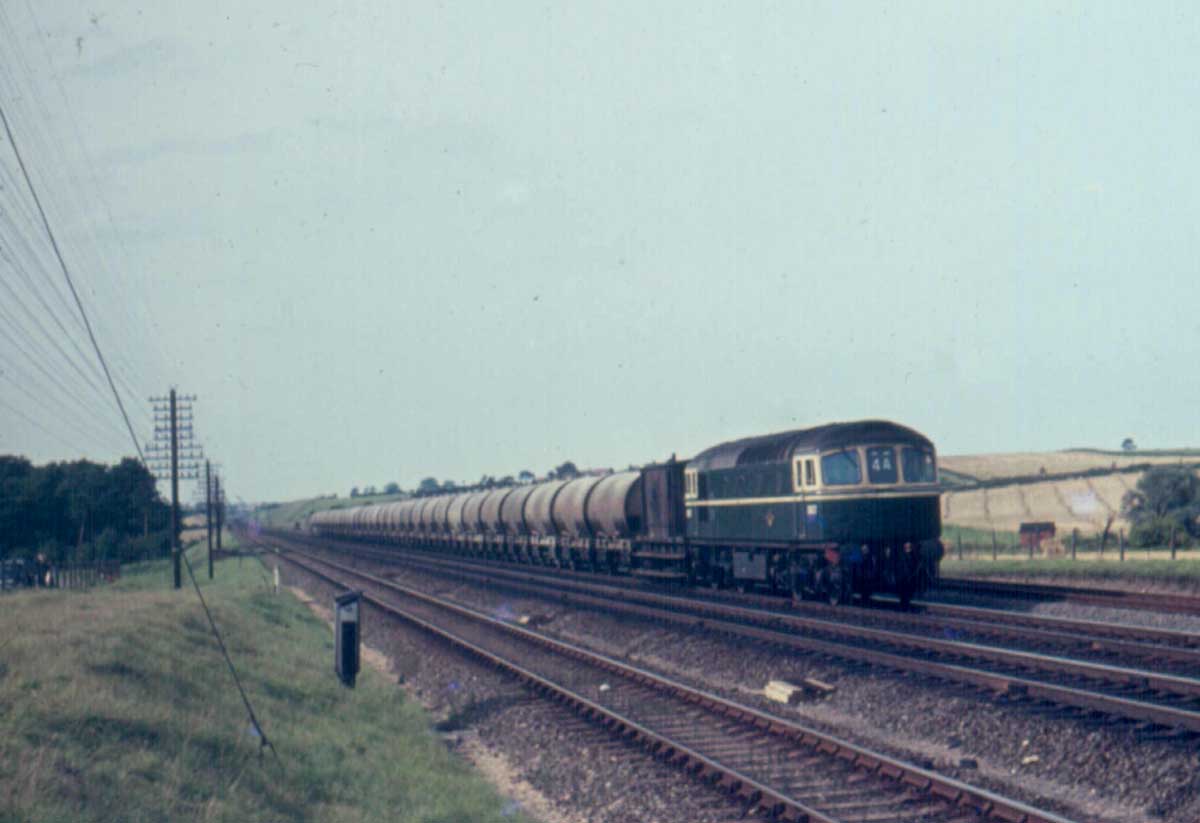
September: Towards the end of September the 8.45am Margate - Wolverhampton passenger was diagrammed for BRCW Type 3 haulage from Margate to Reading General, returning with the balancing working, in each case a reversal was made at Redhill.
October: With the summer over the Type 3s were removed from the Western Division passenger workings due to their lack of train heating boilers. They transitioned to the Fawley oil train workings, at this time travelling as far as Oxford.
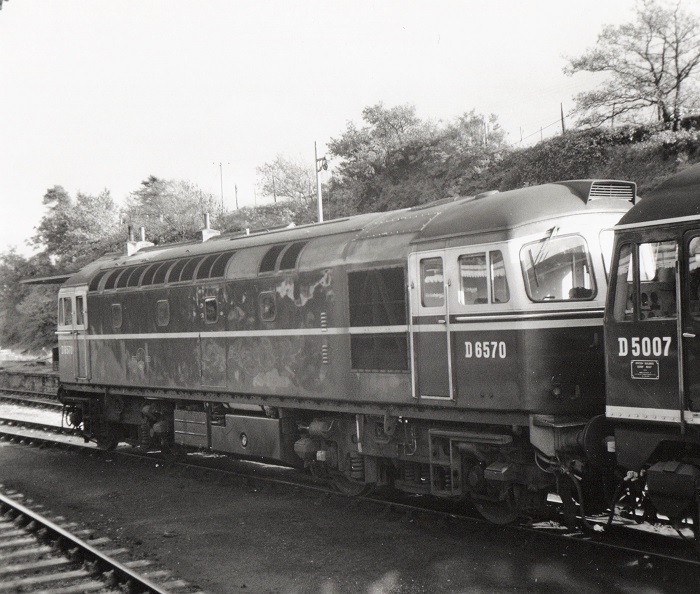
November 3rd: Another Dartford FC football excursion took a Type 2 & Type 3 combination to pastures new. D6570 & D5007 took twelve coaches from Dartford via Nunhead, Clapham Junction, East Putney and Wimbledon to Yeovil Junction, where steam took over for the short trip to Yeovil Town.
December: On frequent occasions the Type 3s on the loaded Uddingston cement tanks returned light engines from York, the empties returning south utilising steam power.
![]()
1963
January: D6518 was sent to Worcester for driver training, pending their use on the Fawley - Bromford Bridge oil trains. It is reported that D6518 was the first main line diesel to be based in the Worcester area, albeit for a short term. As well as local freight workings D6518 was used with a steam locomotive (for steam heating) between January 21st & 25th on the Worcester - Hereford line, working the 7.15am to Hereford, the 10.50am to Paddington (to Worcester), then the ex 9.15am Paddington to Hereford and back to Worcester with the 2.05pm to Paddington. Later in the month D6520/38/46 were in the area for continued training. Elsewhere on the Western Region the Type 3's were working to Southall on the Fawley - Denham oil tanks.
The transfer of the ex-South Tyneside stock headed for use on the Southern Region saw Type 3's hauling the stock from Brent sidings to Eardley for temporary storage.
February: freight rosters for the Feltham & Eastleigh area workings were revised to accommodate the greater use of the Type 3's, with the consequent reduction in the area's steam fleet.
March 4th: Through working of the Type 3's on the Fawley - Bromford Bridge oil tanks commenced. By early summer these workings would be fully dieselised, with Saltley hosting the Type 3's in between turns.
March 23rd: the 08.30am Didcot - Eastleigh mixed freight hauled by D6520 derailed 22 wagons between Highclere & Burghclere. The locomotive remained on the rails and no injuries were sustained by the crew. The derailed vehicles included some short wheelbase steel sided wagons, a bogie bolster carrying steel bar and at least four, presumably empty Esso short wheelbase oil tank wagons returning to Fawley. Rapid expansion of the rails caused by a warm sunny morning following a cold night caused deformation of the track leading to the derailment. The line was reopened late in the afternoon of March 25th.
May: Freight timetable changes on the South Eastern Division freed up a number of Type 3's, allowing for their use on the Oxted line passenger duties. On April 29th training trips commenced between New Cross Gate and Polegate. Initially three round trips commenced with diesel haulage from May 6th, with three more on May 13th and two more June 4th. Services included those by both routes from London to Tunbridge Wells West, some London - Brighton workings over the Uckfield line and London - Eastbourne over the Heathfield line. At night the Type 3's took up a number of freight turns. By June the South Eastern Division duties included Tonbridge - Redhill - Reading freights.
Excursions to visit the recently opened Coventry cathedral (May 1962?) brought visitors from many locations, including D6538 from Margate on May 27th and D6549 from Portsmouth on May 29th.
June: A new working for a Type 3 was the Southampton Docks - Crewe 'Import Express', running via Winchester, Newbury, Didcot and Oxford, with the Type 3 running through to Tyseley. Elsewhere on the South West Division the absence of freights on a Saturday allowed the Type 3's to cover many passenger workings on the Waterloo - Bournemouth & Lymington Pier workings. On the Central Division from July 1st Stewarts Lane had fifteen Type 3's available (nineteen by July 22nd), greatly impacting the steam duties remaining here. Further south, at Brighton the Type 3's took over the Saturday workings of the 9.40am Brighton - Bournemouth & 1.45pm return, D6527 was so noted on June 22nd. The weekday workings continued to be in the hands of the West Country Pacifics.
From time to time during the summer the Waterloo - Bournemouth steam workings were handled by Type 3s, though Brush Type 4's were preferred. on these workings, the Type 3's were certainly put to the test with 12 coach, 400 ton plus trains.
July: by the third week of July eleven more Type 3's had been transferred to Eastleigh, and all the narrow bodied variant (D6586 - D6597) were reallocated to St Leonards (73D).
The end of the summer timetable saw the end of steam servicing at Stewarts Lane, with its allocation of remaining steam locomotives transferred away. Brighton also lost the duties for its Pacifics, they were transferred away, whilst Newhaven and Tunbridge Wells West sheds closed on September 9th. Whilst many factors contributed to these events, no doubt the presence of 98 Type 3's available for traffic was a contributing factor. With autumn and winter approaching steps were taken to ensure the diesel hauled services had enough electrically heated stock to meet the diagrams, requiring transfers of suitable stock from other regions.
On September 19th D6519 worked a Croydon - Coventry (cathedral) special throughout.
November 18th: D6529 hauled the President of Iceland from Gatwick to Victoria, substituting for failed electric locomotive No. E5007.
From December 3rd the Fawley - Bromford Bridge workings now included trains of fifty four tanks cars, worked throughout by pairs of Type 3s. At the end of 1963 these trains were routed away from the Didcot, Newbury & Southampton line, onto the route via Basingstoke & Reading, the majority of the D. N. & S. route would close on August 10th 1964.
![]()
1964
January: modifications to the Central Division freight workings intended to remove all steam workings from the area were effective January 6th. These included several cross London services to Willesden, Brent and Ferme Park, the last destination taking the Type 3's over the Widened Lines for the first time. These changes required four or five Type 3's to be sent over from the South West Division. A total of 36 Type 3's were now engaged on Central Division duties, all were maintained by Hither Green with the diagrams arranged to allow for scheduled maintenance to be carried out at Hither Green. On the Oxted line a revision of the services led to a major overall reduction in passenger train mileage, the elimination of the remaining Uckfield line steam workings and the continued use of the Type 3's on some of these services.
January 9th: D6553 was sent to Derby for static brake tests and then to work a test train of airbraked freightliner vehicles. One test run was made to Leicester and back on January 10th, full testing commenced on January 16th between Derby & Leicester. A dynamometer car was included in the train. D6553 returned home on January 28th, but was soon recorded as on loan to the Western Region.
January 12th: The Sunday only Brighton - Bournemouth became diesel hauled using electrically heated stock borrowed from the Oxted line.
March: D6502 was seriously damaged in a collision on March 5th at Itchingfield Junction, whilst working the 01.50 Brighton - Three Bridges freight, which had been diverted via the Steyning line. It came into collision with the 2.30am Three Bridges Yard - Chichester freight, hauled by D6565. Regretably the crew of D6502 were killed in the collision. The locomotive was withdrawn on May 17th and broken up on site during July, the first mainline Modernisation Plan locomotive to be retired.
June 15th: The Brighton - Lancing Works workmen's train, 'The Lancing Belle' became diesel hauled by a Type 3. The diesel haulage would be brief, the last working into the Works ran on July 3rd. It was replaced by a straight forward set of electric stock working between Brighton & Lancing station.
June: For the summer season a relief Brighton - Cardiff operated using a Type 3 between Brighton & Salisbury. The Type 3's were also utilised on the Brighton - Plymouth & Portsmouth - Cardiff as far as Salisbury. The weekday service used an electric locomotive as far as Chicester, on occasion a Type 3 would substitute.
August: for the period ended August 17th D6540 & 6541 were transferred to Eastleigh. On summer Saturdays ten of the forty nine scheduled mainline departures from Waterloo were Type 3 hauled. The 11am Waterloo - Exeter was hauled throughout by a Type 3, returning on the 16.30 as far as Salisbury.
August 8th: Noted north of Oxford were D6518 on the 10.27 Brighton - Wolverhampton & D6516 on the 08.45 Margate - Wolverhampton.
August 16th: Twelve withdrawn LT Piccadilly Line underground cars were hauled by D6540 from Wimbledon Park to Micheldever for storage, with possible further use on the Isle of Wight.
September: The publication of the electrification plans for the Waterloo - Bournemouth line included a considerable shake-up of the Southern Region locomotive fleet. It would require the Western Division's Type 3 fleet to total fifty, with the difference made up by transfers from Hither Green. Of these, nineteen would be converted for push-pull working on the Bournemouth - Weymouth services. Hither Green would also give up ten of its straight 750V DC electric locomotives, to be converted to electro-diesel layout for working the Southampton Docks boat trains. A further 43 electro-diesel locomotives would be ordered from English Electric, which in conjunction with the new electric multiple unit stock would allow for the elimination of over 250 steam locomotives.
As the summer drew to a close a shortage of Type 3s on the Central Division saw a number of steam locomotives loaned to Redhill and two six car Hastings sets covering Oxted line services. It had been hoped that the loan of the steam locomotives would be short lived, but the continued shortage of Central Division Type 3s well into the New Year saw Redhill keep its steam fleet for a little longer. Possibly due to these shortages there were some unusual steam workings in the area. This included the use of Canklow allocated B1 No.61313 on October 1st working two roundtrip Redhill - Reading passenger services. It had been held at Redhill for many months awaiting repairs, it returned home on October 3rd which included working a train of crippled wagons from Earlswood to Streatham Common, before heading off towards Cricklewood. Another long time resident of Redhill, Black Five No.45346 of Annesley (16B) also received repairs during September and spent the latter half of September on local work including the Redhill - Reading services.
Further shortages occurred in late September as the Southern Region encountered a severe motive power shortage with many of its E5000 series electrics stopped for repairs (mostly awaiting tyre replacements from Eastleigh Works) along with an unusually high number of Hither Green allocated Class 33s out of service. Class 33s were loaned from the Central and South Western divisions and six Class 25s were borrowed from the LMR. Many freights were cancelled whilst the Uddingston cement workings were handled by Brush Type 2s over the ECML from Clarence Yard, Hornsey.
October: The increasing number of Brush Type 4s entering service found them occasionally working the Uddingston cement tanks in place of the more regular Type 3's. On other occasions the Type 3's were working the trains either singly or in pairs.
During November & December a further seven Type 3s were transferred to Eastleigh (70D) from Hither Green, providing Eastleigh with an allocation of about thirty Type 3's.
![]()
1965
January 25th: tests were carried out in the rerouting of the Uddingston cement trains via Hither Green, Blackfriars, Farringdon & the Widened Lines. D6573 was assisted from Faringdon by a Finsbury Park BR/Sulzer Type 2. From time to time Brush Type 4s and several steam types filled in due to failure or non-availability of the Type 3's.
On May 19th a Bexhill on Sea - Coventry special was worked throughout by D6529.
As a step towards the removal of steam from the Waterloo - Bournemouth services, D6580 was modified for remote operation with a modified rake of electric multiple unit stock (6TC sent No.601) and tested between Wimbledon Park & Basingstoke commencing July 21st. The following month the newly delivered 4-TC stock was available for high speed testing on the Bournemouth line. The addition of the three jumpers on each side of the cabfront of D6580 and the selection of a small rectangular yellow warning panel did not improve the aesthetics of the cab front. D6580 would later be modified to have its push-pull equipment conform to the other 18 locomotives.
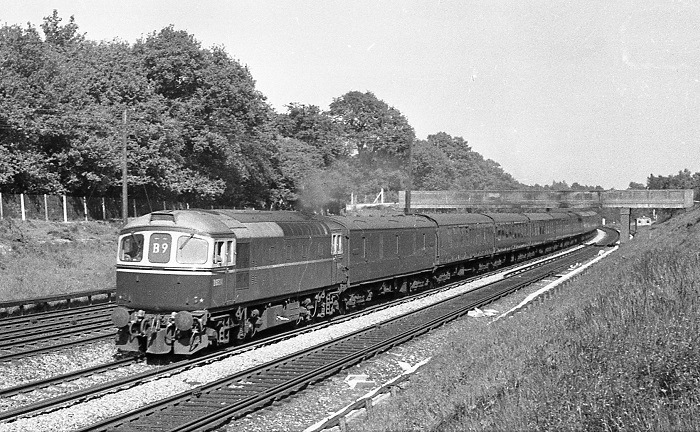
Following the end of the summer timetable the Brighton - Plymouth service would be the only long distance service from Brighton of those that once ran to the likes of Bournemouth and Cardiff. The Plymouth service was hauled by Type 3's during the summer. Steam would continue to handle the winter workings, but the arrival of dual heated stock would allow the Type 3's to take over.
The allocation of the Type 3s from Hither Green to Eastleigh appeared to be numerically on a random basis, however the transfers in October would lead to Eastleigh having the allocation of D6500 - D6552 & D6580.
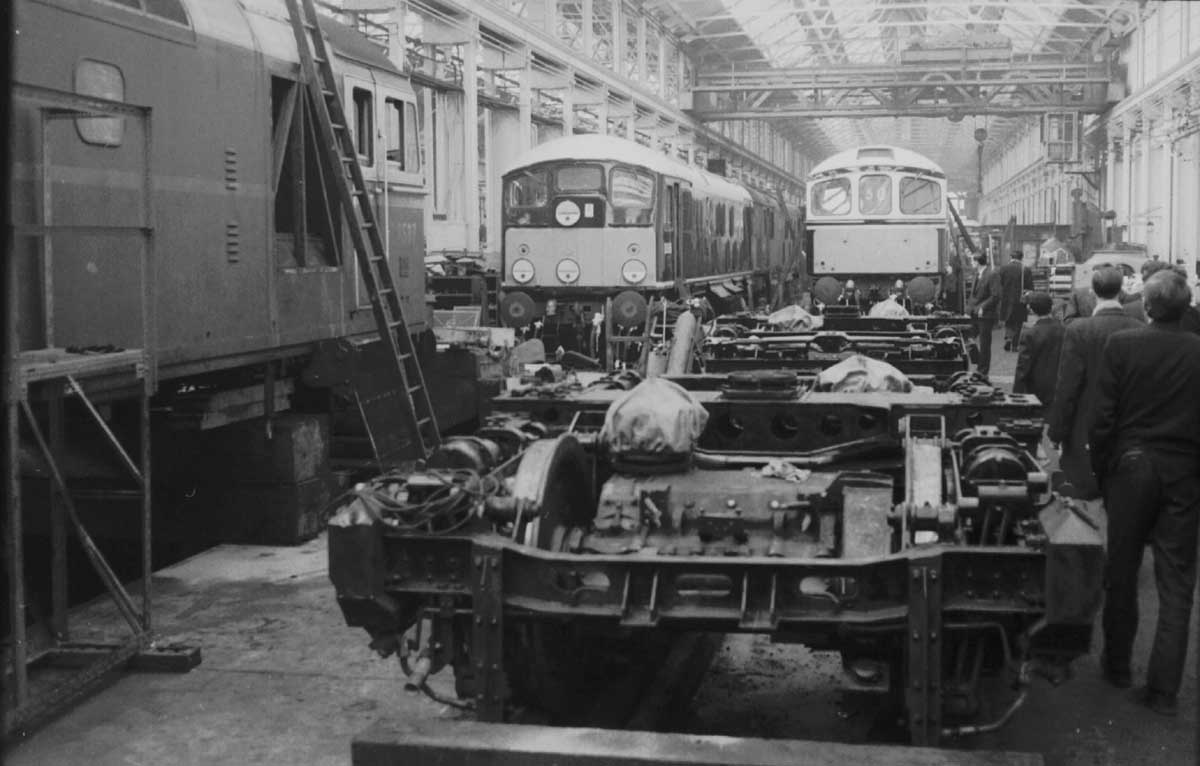
On November 21st withdrawn S15s 30840 & 30843 were noted arriving at Queenborough from Feltham behind D6563.
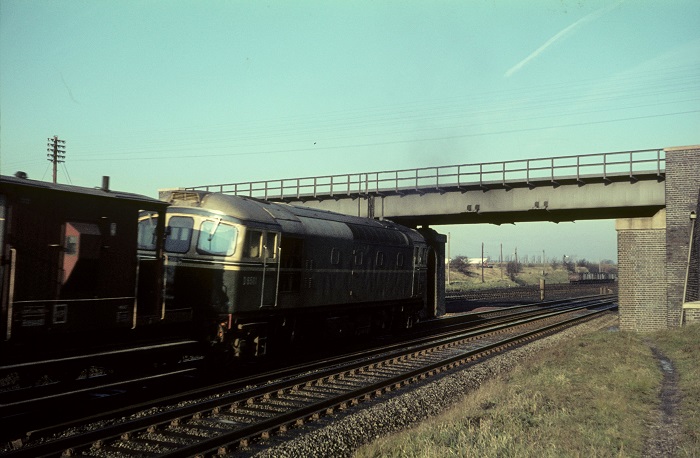
![]()
1966
January 17th & 20th: Blizzard conditions in the south-east saw the Dover Marine - Victoria 'Night Ferry' hauled by two Type 3's instead of the more normal electric locomotive. The newly arriving electro-diesels (upto E6017 by January) were allowing the release of Type 3s to other duties.
On January 21st a York - Hull freight was worked by D6546, the locomotive immediately returning to York light engine. Presumably the presence of the Type 3 at York was connected to the Cliffe - Uddingston cement trains?
During 1966 the engine in D6504 suffered a serious failure when the crankshaft broke. Investigation revealed that the torsional damper had overheated and seized, thus becoming ineffective and allowing the crankshaft to undergo stresses well in excess of their design. Locomotives visiting Eastleigh Works were inspected for similar problems, whilst reports of heavy and unusual vibrations in engines in service confirmed other dampers were not functioning correctly. The dampers originally fitted were 'factory sealed for life' according to their manufacturers. In reality however the high viscosity fluid in the dampers at times was not able to distribute away the heat generated leading to the failure of the damper. The fix was relatively straight forward - a plug was fitted to allow for testing of the fluid and the 'sealed for life cover' was replaced by a bolt-on type allowing for an easy change of the fluid if deemed necessary. This issue was not confined just to the Sulzer make of engine, investigation of other makes found similar issues.
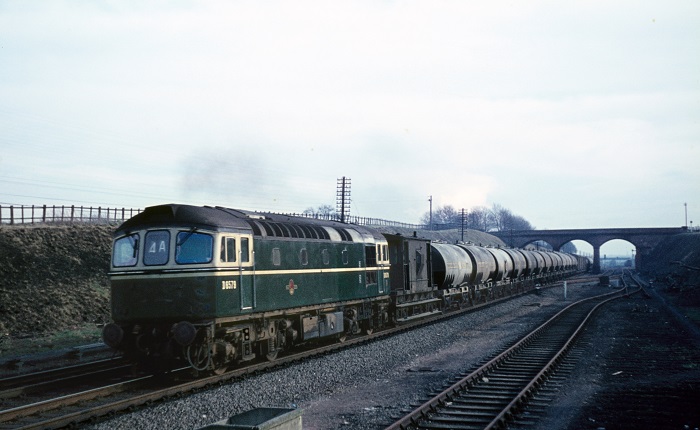
May 20th: Special coal trains were run from the North East to London to mitigate the effects of a seamanís strike. D6570 which should have returned south with the cement empties was instead used to work one of the coal trains to the London area.
The summer again brought more passenger workings for the Type 3s on the Bournemouth line, particularly on Sundays, including pairs of locomotives on the Bournemouth Belle. Lineside observation on the South Western Division found about one third of the locomotive hauled passenger services in the hands of Type 3ís. For the cross country workings via Reading the locomotive changes frequently took place at Basingstoke. For the inter-regional passenger workings to the Central & South Eastern Divisions, the Type 3ís were now handling many of these workings to/from the Regional boundaries.
July 3rd & 10th: Because of scheduled engineering work the 06.00am Weymouth Ė Waterloo boat train was routed via Trowbridge, Chippenham & Swindon, powered by D6548 & D6508 respectively.
On the morning of July 9th D9012 failed at Doncaster with a Newcastle - Kings Cross service, D6539, presumably off the cement working was used to remove D9012 from its train.
July: The application of the cab front small yellow warning panel came late to the Type 3s, D6530 was the first to be so treated (in the spring of 1966?), it was not until July/August that others were so treated.
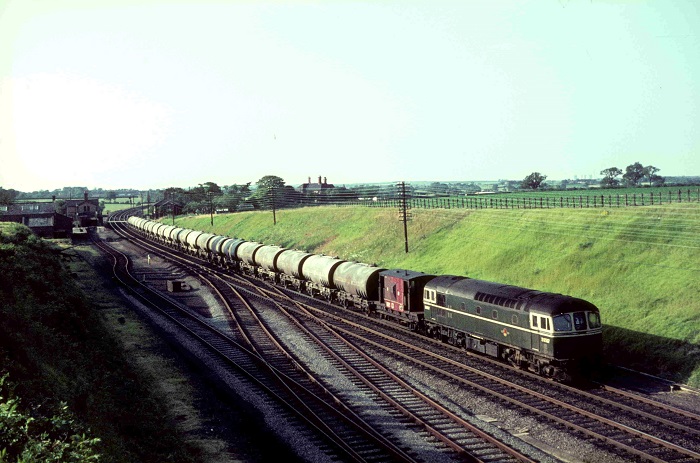
August: Further testing of the TC units including some high speed runs to Bournemouth were carried out with D6580. The tests were shortlived pending delivery of suitably equipped South West Division Type 3s. The first public services began on August 15th using three 4TC units and D6542 on the 09.30 Waterloo - Bournemouth. Following the successful testing of push-pull equipped D6580 in the summer of 1965 Eastleigh now began conversion of nineteen locomotives with the next example D6521 (???) being out-shopped and tested between Farnham & Alton during the last week of September.
September 30th: D6535 working the 19.53 Redbridge - Feltham freight ran through catch points at Weston signalbox with the locomotive ending up in an adjacent field. Initial attempts to recover the locomotive on October 2nd failed, it was successfully recoved on October 9th.
The arrival of the winter season again saw the Type 3s generally pulled from those passenger workings using steam heated stock. On the Southwestern Division although there were more Brush Type 4s in use, the winter services still relied heavily on the dwindling steam fleet. As stock became available and various engineering works were completed further diagrams converted to Type 3's with 4TC stock, some being worked in push-pull mode. These services from Waterloo included workings to Basingstoke, Eastleigh & Waterloo.
Working of the Uddingston cement trains continued in the hands of the Type 3s, they were now routed over the North London line, instead of via Holborn Viaduct and the Widened lines. On December 2nd D6589 and 4TC set No. 424 was noted passing Finsbury Park.
The Bournemouth electrification project recognised that it was not cost effective at the time to extend the electrification to Weymouth. To permit through services to/from Waterloo the eight/twelve car electric multiple unit sets (4-TC + 4-REP) were split at Bournemouth with a push/pull equipped Class 33/1 taking the 4-TC on to Weymouth. Nineteen Class 33s were converted at Eastliegh for this purpose. D6580 was the first to be converted and emerged from Eastleigh Works still in green livery, all the other Class 33/1s emerged in the corporate blue/yellow livery. The clean lines of the cab front were lost with the addition of waist level brake and multiple unit working pipes, vestible rubbing plates, buckeye couplings and pneumatic retractable buffers. Although nineteen Class 33s were converted to push-pull working only four were required to handle the daily Bournemouth - Weymouth diagrams. The conversion of these machines required several problems to be solved. The locomotives used BR's standard 110V for the control lines, the EMUs used 70V. To resolve this issue the rolling stock was equipped to handle the 110V. The EMU controller had only four positions, it was necessary to create a means of translating these four positions into something useable by the locomotive to control the engine speed. The push-pull working was introduced on December 12th, the diagram was the 07.15 Eastleigh - Waterloo, 09.30 Waterloo - Bournemouth (loco at rear), 15.23 Bournemouth - Waterloo & 19.30 Waterloo - Bournemouth. On this first day D6521 worked the first three parts of the diagram.
![]()
1967
January: Four turns from Waterloo were now operated by Type 3s with 4TC stock, whilst one of the morning commuter trains from Basingstoke was Type 3 hauled with 4TC stock. With the first 4-REP unit expected in February this variety of Type 3 workings would soon disappear.
January 22nd: D3219 became completely derailed at Steyning whilst working the Steyning line demolition train. D6556 attended later with a breakdown crane.
During February push-pull fitted D6521 acquired a new weekday diagram for crew training purposes. It commenced with the 10.15 Eastleigh - Southampton Central ECS, 10.43 Southampton Central - Bournemouth (propelling), 15.23 Bournemouth - Waterloo (propelling), 20.04 Waterloo - Southampton Eastern Docks parcels, then light to Eastleigh depot.
On March 6th the Brighton - Plymouth through service was cut back to Exeter. On March 14th D6583 was noted passing Newark light engine northbound to York?, returning southbound later in the day with a four car Southern Region electric multiple unit. A similar move took place on March 22nd with D6520, but with a unit attached in each direction.
On April 13th Schools Class 4-4-0 No. 30926 & M7 0-4-4T No. 30053 began their long journey from Preston Park to Canada. The first part of the journey, to Willesden was hauled by D6547.
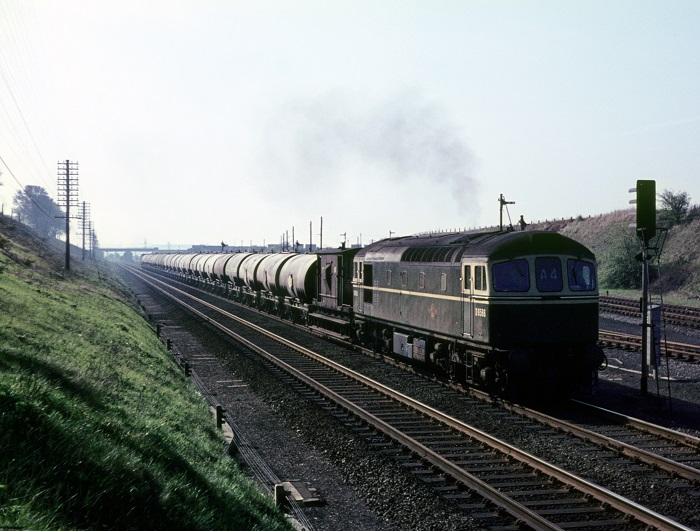
May 6th: D6544 departed Eastleigh towing 30073, 73169, 75069 & 76057 for scrap.
May 25th: A New Cross Gate - Stratford upon Avon excursion was hauled throughout, via Redhill & Reading by D6537. On the return the Type 3 failed at Redhill.
July 1st: D6519 noted at Weston super Mare with a set of coaches.
June and July had seen the last mainline in the United Kingdom, the Waterloo - Bournemouth route, to operate an intensive timetable of steam hauled passenger trains. With more new electric multiple units being received from the workshops and the conversion of a group of Class 33s to push/pull operation progressing well, the withdrawal of the steam locomotives supporting this route reached eighty five during June & July. On July 9th the last steam workings took place prior the next next day's full inauguration of the Waterloo - Bournemouth electrification. The late delivery of the converted E5000 series electro-diesels saw pairs of the E6000 series electro-diesels or the Type 3 diesels filling on some turns out of Waterloo. With the withdrawal of steam the two weekday morning & evening Clapham Jct - Kensington Olympia service were worked by D6568 on July 10th. On the same date the Central and South Eastern Division locomotive diagrams were merged. This allowed the St Leonard's allocated Hastings gauge Type 3's to wander further on a regular basis than previously, now handling passenger workings from London to Brighton, East Grinstead, Crowborough and the weekday Clapham Jct - Kensington rush hour turns
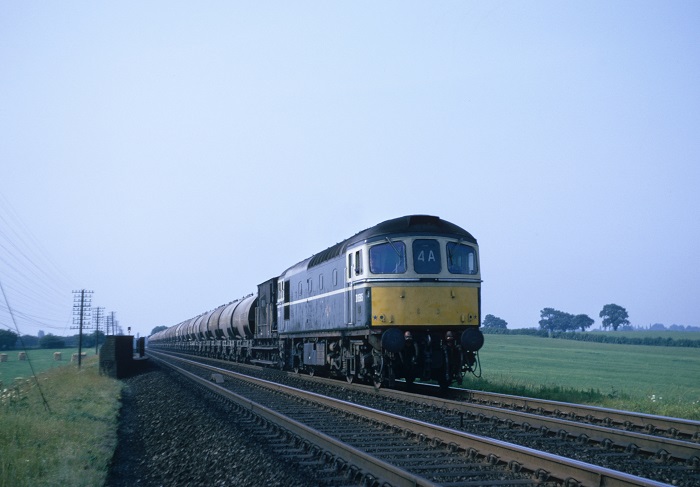
August 26th: the 09.57 Brighton - Exeter relief (via Westbury & Taunton) brought one of the Hasting gauge Type 3's, D6597 to Exeter, possibly for the first time. Also at Exeter St David's on the same day was D6583 on the 8.00am from Waterloo which had been extended to St David's. The Type 3's occasionally replaced the Warships on the Waterloo services.
August/September: the movement of steam engines away from Nine Elms had become a regular Sunday early afternoon movement. Workings noted were: Aug 27th D6555 with 34008, 34034 & 35007; Sept 3rd D6517 with 34001, 34013 & 35030; Sept 10th D6549 with 35023 & 34084.
During October the number of push-pull equipped Class 33s required was revised downwards from 30 to 19.
Type 3 allocations as at December 31st 1967:
Eastleigh: D6500/01/03-46/48-54/78/80
Hither Green: D6547/55-77/79/81-97
Withdrawn: D6502
![]()
1968
January: the northbound Cliffe - Uddingston cement train was diverted to run via the joint line at a maximum speed of 35mph. The southbound empties continued to run over the East Coast main line.
February: the first of the rebuilt E50xx class, now classed E61xx were delivered from Crewe Works, their delivery would no doubt have a small impact on some of the existing Type 3 workings over the South Western division main line.
April 18th: D6525 failed in Southampton Tunnel with the 15.30 Waterloo - Swanage, for reasons now long forgotten this failure and subsequent delays drew the attention of the press and television.
May: the Southampton - Edge Hill freight workings frequently brought Type 3's to Bescot, running over the ex-Great Western route to Leamington, then Kenilworth, Berkswell, Stechford and Bescot, where electric traction took over. For the summer season the Saturdays Brighton - Exeter service utilised pairs of Type 3's.
June 1st: an unusual vistor to Newton Abbot was D6507, which took empty coaching stock from here to Paignton to form a Senior Citizens return excursion to Hastings, the first of the class to visit Paignton?
During the summer a number of Type 3's reached Cardiff on Saturday workings and also a mid-morning relief from Portsmouth Harbour.
August: with the withdrawal of steam a new classification for diesel & electric locomotives was introduced with the BRCW Type 3's becoming the Class 33's. The push-pull equipped Type 3's for a brief while were designated as Class 34. During August 1969 the Class 33 designation was expanded to include 33/1 (standard), 33/2 (push-pull) & 33/3 (narrow body), these were later amended to 33/0, 33/1, 33/2 respectively.
On September 7th narrow bodied 6586 & 6594 were paired together on the Brighton - Exeter St Davids service.
During October?? the Southern Region provided a forecast for the number of Class 33s it would need over the ensuing six years to the end of 1974. The stock at October 5th 1968 was 97 and the forecasts for each succeeding year end from 1968 to 1974 were 87, 87, 79, 79, 79, 79, 79. A note advises the surplus, after allowing for D6576 being condemned in November 1968, will be retained at least until 1971 whilst modifications are carried out to improve reliability and availability. In the event, some of the surplus was put on Waterloo-Exeter line diagrams, releasing Class 42 to be withdrawn in its entirety at the start of 1972.
Thank you for obtaining the feedback from Stephen regarding Class 37. Kind regards David November: Class 33 No. 6576 was withdrawn after sustaining collision damage at Reading. It would be broken up at Eastleigh during March 1969.
On November 7th preserved 42500 began its journey from storage at Preston Park, Brighton to Attleborough, with 6557 taking it as far as Clapham Junction. Two weeks later on November 21st 70000 was removed from Preston Park to Redhill by 6554.
December 18th: a special oil working from Fawley to Grangetown (between Cardiff & Barry) was worked throughout by a Type 3, the locomotive immediately returning light engine to Eastleigh.
Type 3 allocations as at December 31st 1968:
Eastleigh: D6500/01/03-51/53/54/80
Hither Green: D6552/55-75/77-79/81-97
Withdrawn: D6502, D6576
![]()
1969
A weekly Fawley - Plymouth Friary oil working was frequently hauled by a Class 33. The locomotive would return light engine to the Southern Region. The route was via Salisbury, Westbury & Taunton. During the summer the Class 33s were further allowed to handle these trains between Plymouth Friary and Cattewater Harbour.
On January 19th 6584 was noted hauling U Class 2-6-0 No.31618 through Halling, the steam locomotive being en-route from Woodhams, Barry to New Hythe for preservation.
During April 6512 was noted at Eastleigh Works receiving repairs to damage sustained after colliding with bufferstops somewhere in the London area.
On May 15th two wagons on a Brighton - Temple Mills freight became derailed near Balham, the wagons struck a Victoria - Bognor Regis service, comprised of 2-BIL No.2080 & 2-HAL No.2696, the 2-BIL unit suffered much damage, with a total of 26 persons injured. The locomotive on the freight train, 6574 remained on the track with no damage.
June: 6570 was at the Research Center, Derby. On June 30th 6531 sustained fire damage at Wool whilst working the the 11.35 Weymouth - Waterloo service.
The Class 33s again returned to Cardiff on summer passenger workings, with two Portsmouth - Cardiff turns, one returning to Portsmouth direct, the other via Bristol. On the Brighton - Exeter service the summer Saturday workings were again double headed, and on the Fawley - Plymouth Cattlewater harbour oil train the Class 33s had been passed to work to the entire trip.
November: Oil train workings from Fawley to Northampton were frequently hauled by Class 33s.
Type 3 allocations as at December 31st 1969:
Eastleigh: D6500/01/03-55/80
Hither Green: D6556-75/77-79/81-97
Withdrawn: D6502, D6576
![]()
![]()
Resources
Sulzer Types 2 & 3, ATH Taylor, Ian Allan BR Locomotive 2, publ 1984 ISBN 0711013403
Rail No. 307 (June 18th - July 1st 1997)
Period magazines: Railway Magazine, Trains Illustrated, Railway Observer, LCGB Journal, SLS Journal
Rail Express June 2019: Cemflo article.
Page added July 29th 2012.
Last updated January 21st 2023.
The Class 33s: 1970 - 1979
The Class 33s: 1980 - 1989
The Class 33s: 1990 - ??